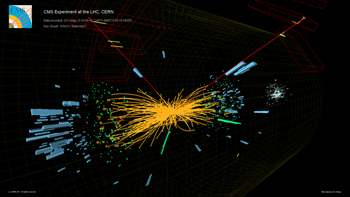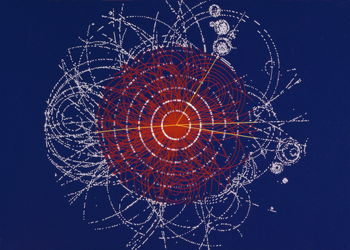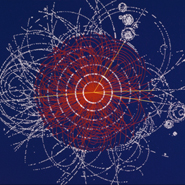Posted 14 December 2011
Physicists focus in on Higgs boson – the so called ‘God particle’
Two experimental physics groups at CERN, the European Organisation for Nuclear Research - the world's leading laboratory for particle physics - have reported significant progress in the search for the Higgs boson, referred to as the ‘God particle’ in popular culture.
The news from the ATLAS and CMS experiments was received with great interest in the UCD School of Physics, University College Dublin, where a group of physicists is looking for the Higgs at the LHCb experiment, a third detector on the LHC collider ring.
Funded by a Science Foundation Ireland (SFI) RFP grant, Ph.D. students Stephen Farry and Philip Ilten are looking for the decay of the Higgs to two tau leptons (the tau lepton is essentially a very heavy electron). They have already observed the decay of the Z boson to tau leptons and their results were shown at this year's EPS conference in Grenoble.
"Finding the Z was a proof of principle; but the Higgs is a much more elusive beast", said Dr Ronan McNulty who heads-up the team at University College Dublin, the only university in Ireland where experimental particle physics research is performed.
The latest results from the ATLAS and CMS experiments at CERN rule out most of the allowed region where the Higgs could be hiding, and narrow its location to a small window between 116 GeV and 127 GeV.
This means the Higgs is relatively light and makes the search more difficult due to the large number of background processes that mimic its signature. More data is required to understand whether what was presented on 13 December 2001 was merely a statistical fluctuation of the background, or whether we have just caught the first glimpse of the Higgs.

Real CMS proton-proton collisions events in which 2 high energy electrons and two high energy muons are observed. The event shows characteristics expected from the decay of a Higgs boson but is also consistent with background Standard Model physics processes. 2011 CERN
The news from CERN gave tantalising hints of a Higgs boson with a mass of about 125 GeV, which would mean that about 5000 Higgs particles have already been produced inside LHCb.
Higgs bosons, if they exist, are very short lived and can decay in many different ways. Discovery relies on observing the particles they decay into rather than the Higgs itself. Both ATLAS and CMS have analysed several decay channels, and the experiments see small excesses in the low mass region that has not yet been excluded.
Taken individually, none of these excesses is any more statistically significant than rolling a die and coming up with two sixes in a row.
What is interesting is that there are multiple independent measurements pointing to the region of 124 to 126 GeV. It's far too early to say whether ATLAS and CMS have discovered the Higgs boson, but these updated results are generating a lot of interest in the particle physics community.

Example of simulated data modelled for the ATLAS detector on the Large Hadron Collider (LHC) at CERN, which will begin taking data in 2008. The Higgs boson is produced in the collision of two protons at 14 TeV and quickly decays into four muons, a type of heavy electron that is not absorbed by the detector. The tracks of the muons are shown in yellow. Photograph: Taylor, L; McCauley, T. 1995 CERN
"We have restricted the most likely mass region for the Higgs boson to 116-130 GeV, and over the last few weeks we have started to see an intriguing excess of events in the mass range around 125 GeV,"explained ATLAS experiment spokesperson Fabiola Gianotti.
“This excess may be due to a fluctuation, but it could also be something more interesting. We cannot conclude anything at this stage. We need more study and more data. Given the outstanding performance of the LHC this year, we will not need to wait long for enough data and can look forward to resolving this puzzle in 2012."
"We cannot exclude the presence of the Standard Model Higgs between 115 and 127 GeV because of a modest excess of events in this mass region that appears, quite consistently, in five independent channels," explained CMS experiment Spokesperson, Guido Tonelli.
"The excess is most compatible with a Standard Model Higgs in the vicinity of 124 GeV and below but the statistical significance is not large enough to say anything conclusive. As of today what we see is consistent either with a background fluctuation or with the presence of the boson. Refined analyses and additional data delivered in 2012 by this magnificent machine will definitely give an answer."
Over the coming months, both the ATLAS and CMS experiments will be further refining their analyses in time for the winter particle physics conferences in March. However, a definitive statement on the existence or non-existence of the Higgs will require more data, and is not likely until later in 2012.
The Standard Model is the theory that physicists use to describe the behaviour of fundamental particles and the forces that act between them. It describes the ordinary matter from which we, and everything visible in the Universe, are made extremely well. Nevertheless, the Standard Model does not describe the 96% of the Universe that is invisible. One of the main goals of the LHC research programme is to go beyond the Standard Model, and the Higgs boson could be the key.
A Standard Model Higgs boson would confirm a theory first put forward in the 1960s, but there are other possible forms the Higgs boson could take, linked to theories that go beyond the Standard Model. A Standard Model Higgs could still point the way to new physics, through subtleties in its behaviour that would only emerge after studying a large number of Higgs particle decays. A non-Standard Model Higgs, currently beyond the reach of the LHC experiments with data so far recorded, would immediately open the door to new physics, whereas the absence of a Standard Model Higgs would point strongly to new physics at the LHC's full design energy, set to be achieved after 2014. Whether ATLAS and CMS show over the coming months that the Standard Model Higgs boson exists or not, the LHC programme is opening the way to new physics.
(This article was adapted from material provided by CERN)
CERN
CERN, the European Organization for Nuclear Research, is the world's leading laboratory for particle physics. It has its headquarters in Geneva. At present, its Member States are Austria, Belgium, Bulgaria, the Czech Republic, Denmark, Finland, France, Germany, Greece, Hungary, Italy, the Netherlands, Norway, Poland, Portugal, Slovakia, Spain, Sweden, Switzerland and the United Kingdom. Romania is a candidate for accession. Israel is an Associate Member in the pre-stage to Membership. India, Japan, the Russian Federation, the United States of America, Turkey, the European Commission and UNESCO have Observer status.
ATLAS
ATLAS is a particle physics experiment at the Large Hadron Collider at CERN. The ATLAS Collaboration is a virtual United Nations of 38 countries. The 3000 physicists come from more than 174 universities and laboratories and include 1000 students.
CMS
The Compact Muon Solenoid (CMS) experiment is one of the largest international scientific collaborations in history, involving more than 3000 scientists, engineers, and students from 172 institutes in 40 countries.
(Produced by UCD University Relations)

